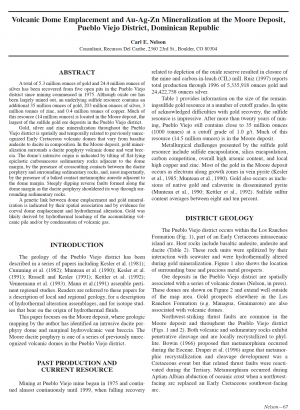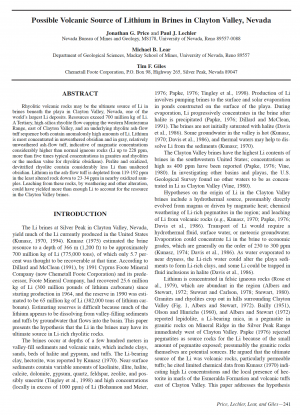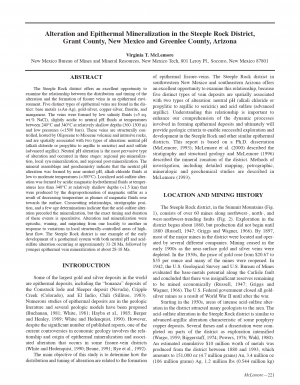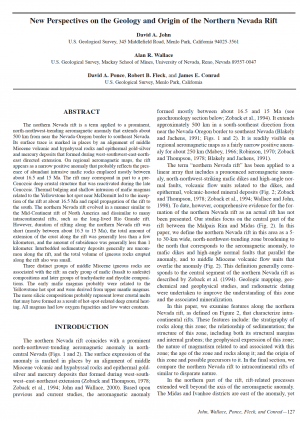Description
Carbonate Replacement Deposits (CRDs) are epigenetic, carbonate-hosted, high
temperature (> 250°), intrusion-related, high-grade, sulfide-rich, polymetallic systems that form through repeated coupled dissolution/precipitation silicate and sulfide
replacement reactions between hydrothermal fluids and carbonate-dominant wallrocks. Major recent discoveries have sparked a CRD exploration renaissance using
advances in their understanding that facilitate vectoring towards their richest zones.
This includes textural features at varying scales related to time/space positioning
within a district.
Undisturbed CRDs show a continuous spectrum of mineralization and alteration
styles from their intrusive centers to distal-most alteration and are zoned at isotopic to district scales. Zoning varies both with respect to process-related igneous and
ore fluid evolution, and with the often highly variable stratigraphic and structural
characteristics of the ore depositional environments. Deciphering the results of this
interplay between process and environment in a target district is crucial not only for
vectoring to ore, but in determining whether detailed exploration is even warranted.
The largest and most economically important CRDs show multiple intrusive and
hydrothermal stages that provoked repeated reactions between the products of individual fluid pulses. This is readily seen in macroscopic and microscopic igneous, ore,
gangue and alteration mineral textures. Overprinting complexity diminishes away
from the proximal zone and orefluid pathways, so textural complexity alone is a firstorder exploration vector.
Intrusions related to significant CRDs are typically multi-stage systems ranging
from productive Porphyry Copper-Moly systems to barren stocks. These show classically recognizable compositional and textural variations and typically show evolution
from relatively intermediate to highly felsic compositions. Thermal metamorphism
(skarnoid and hornfels) tends to be related to early phases with metasomatic skarn
and economic sulfide mineralization associated with later, more silicic differentiates.
Large-scale magmatic brecciation textures may indicate premature pressure release
resulting in excessive dispersion of mineralizing fluids.
Significant CRDs always show complex sulfide paragenesis, generally marked by
repeated deposition of certain species, complex intergrowths, overprinting, recrystallization and pseudomorphing. Increasing sulfide replacement of calc-silicates is
generally a good proximity vector and increasingly irregular wallrock contacts are
a good indicator of distal, more passive orefluid migration. Proximal sphalerite is
often opaque or dark colored, becoming progressively lighter in color later or more
distal. Galena in the distal zones often shows distinctive textures reflecting high silver
content. The most important sulfide texture is pyrite replacing pyrrhotite. This distinctive texture stems from a kinetically very slow sulfidation reaction, so its presence
alone indicates a long-lived, multistage CRD system probably worth exploring.
CRD evolution and zoning are also reflected in gangue/alteration textures. Replacement redistributes the wallrock carbonate dissolved during mineralization into a halo of secondary “fugitive calcite” veinlets. This calcite often incorporates manganese from “spent” ore fluids, which causes orange-red fluorescence under Ultraviolet
light. Veinlet density and fluorescence both diminish distally, providing a very useful vector. Silica textures also vary systematically, with extremely fine-grained silica
flooding in the proximal intrusive environment, medial coarse quartz “knots” formed
during retrograde skarn alteration and ferruginous jasperoid distal to sulfides. Crosscutting “epithermal” textures are good indicators of a shift to hydrostatic conditions
during system collapse.
CRD wallrock alteration varies widely in nature and extent depending on: proximity to ore-fluid migration channels; attitude of bedding with respect to mineralization; wallrock composition; permeability; and porosity. Alteration tends to be more
pervasive and laterally extensive closer to fluid migration pathways, especially where
bedding is at a high angle to fluid movement. Alteration of non-carbonate and impermeable wallrocks is typically limited to immediate ore contacts with fracture-controlled offshoots. Carbonate wallrocks show varying metamorphic and hydrothermal
effects zoned with respect to ore fluid channels and intrusions. The most common outwards zoning is: coarse to fine-grained marble (± bleaching); progressively weakening recrystallization; intergranular solution (sanding); silicification and dolomitization. Argentiferous manganese-oxide impregnations, chloritization and fluoritization
are rarer but exceptionally useful zoning indicators where present.






